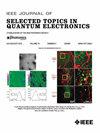Integrated Photonics and Electronics for Optical Transceivers Supporting AI/ML Applications
IF 5.1
2区 工程技术
Q1 ENGINEERING, ELECTRICAL & ELECTRONIC
IEEE Journal of Selected Topics in Quantum Electronics
Pub Date : 2025-02-06
DOI:10.1109/JSTQE.2025.3539379
引用次数: 0
Abstract
The recent proliferation of artificial intelligence and machine learning applications relying on large language models is fueling unprecedented demand for compute capacity. Associated with this is a need to scale capacities of short-reach optical transceivers towards multiplex Terabit/s, while maintaining integration density (frontpanel or beachfront density) and energy efficiency (pJ/bit). One option to scale transceiver capacity is to increase the bandwidth per lane from today's 200 G to 400 G or even higher: coherent transceiver technology is then expected to play an ever more important role. Photonics and electronics with higher bandwidths beyond 100 GHz will play a crucial role. Integration of thin-film LiNbO3 modulator onto a Silicon Photonics platform is shown to be a viable option to meet the needs for new generations of optical transceivers. Front-end electronics such as linear modulator drivers and transimpedance amplifiers can rely on traveling-wave design approaches to allow continued bandwidth scaling despite (relative) slowing transistor speeds. Novel wireline data converter architectures can be used to overcome limitations of existing implementations. Maintaining signal integrity from photonics and electronics can be facilitated using both 2.5D and 3D integration approaches. While the introduction of novel materials and architectures will require time to further mature, optical transceivers operating at baudrates up to and beyond 200 Gbaud are now just beyond the horizon.支持AI/ML应用的光收发器集成光子学和电子学
最近依赖于大型语言模型的人工智能和机器学习应用程序的激增正在推动对计算能力的前所未有的需求。与此相关的是需要将短距离光收发器的容量扩展到多路太比特/秒,同时保持集成密度(前面板或海滨密度)和能源效率(pJ/bit)。扩展收发器容量的一种选择是将每通道带宽从今天的200g增加到400g甚至更高:相干收发器技术预计将发挥越来越重要的作用。超过100千兆赫的更高带宽的光子学和电子学将发挥至关重要的作用。将薄膜LiNbO3调制器集成到硅光子学平台上是满足新一代光收发器需求的可行选择。前端电子器件,如线性调制器驱动器和跨阻放大器,可以依靠行波设计方法,允许持续的带宽缩放,尽管(相对)减慢晶体管速度。新的有线数据转换器架构可以用来克服现有实现的局限性。使用2.5D和3D集成方法可以方便地保持光子学和电子学的信号完整性。虽然新材料和新架构的引入需要时间来进一步成熟,但波特率高达或超过200gaud的光收发器现在已经超越了地平线。
本文章由计算机程序翻译,如有差异,请以英文原文为准。
求助全文
约1分钟内获得全文
求助全文
来源期刊

IEEE Journal of Selected Topics in Quantum Electronics
工程技术-工程:电子与电气
CiteScore
10.60
自引率
2.00%
发文量
212
审稿时长
3 months
期刊介绍:
Papers published in the IEEE Journal of Selected Topics in Quantum Electronics fall within the broad field of science and technology of quantum electronics of a device, subsystem, or system-oriented nature. Each issue is devoted to a specific topic within this broad spectrum. Announcements of the topical areas planned for future issues, along with deadlines for receipt of manuscripts, are published in this Journal and in the IEEE Journal of Quantum Electronics. Generally, the scope of manuscripts appropriate to this Journal is the same as that for the IEEE Journal of Quantum Electronics. Manuscripts are published that report original theoretical and/or experimental research results that advance the scientific and technological base of quantum electronics devices, systems, or applications. The Journal is dedicated toward publishing research results that advance the state of the art or add to the understanding of the generation, amplification, modulation, detection, waveguiding, or propagation characteristics of coherent electromagnetic radiation having sub-millimeter and shorter wavelengths. In order to be suitable for publication in this Journal, the content of manuscripts concerned with subject-related research must have a potential impact on advancing the technological base of quantum electronic devices, systems, and/or applications. Potential authors of subject-related research have the responsibility of pointing out this potential impact. System-oriented manuscripts must be concerned with systems that perform a function previously unavailable or that outperform previously established systems that did not use quantum electronic components or concepts. Tutorial and review papers are by invitation only.
 求助内容:
求助内容: 应助结果提醒方式:
应助结果提醒方式:


